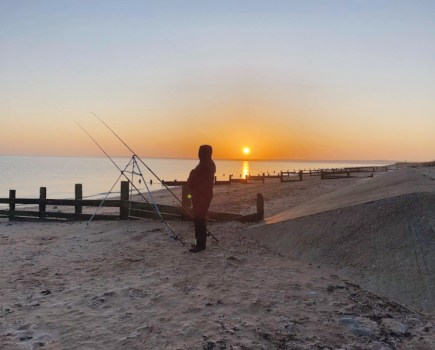Here are four of the most iconic sea fishing venues where you can fish from the surf. Take a look at our detailed guides on the below beaches that offer a great day of sport.
Whether you’re after flounder, bass or cod we’ve got you covered with these great sea fishing near me venues that are accessible to the everyday angler.
You can even plan your journey and figure out where the best place to stay is on your fishing trip with our recommendations. We even point out where the nearest sea fishing tackle shop is!
1) Llangennith
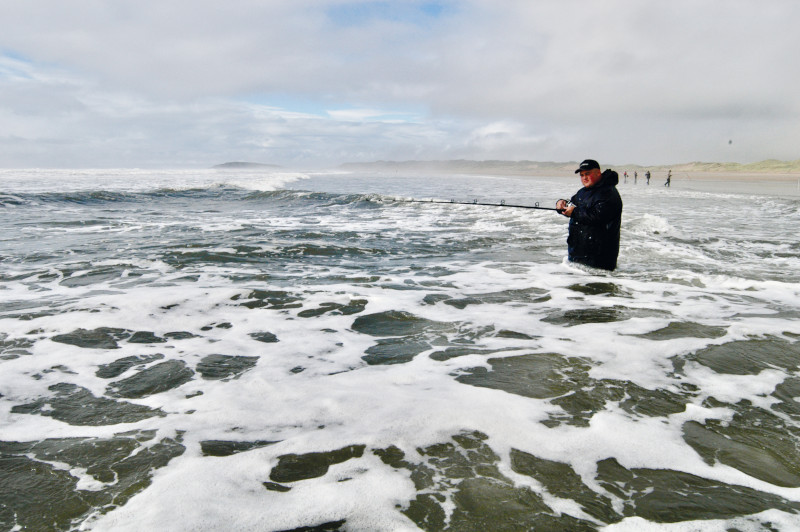
Located on the Gower coast in South Wales, Llangennith beach is a vast expanse of golden sand which extends for several miles in a southerly direction from the tidal island of Burry Holmes to the clifftop village of Rhosilli.
I’ve fished at Llangennith for almost 50 years and this is undoubtedly my favourite British shore angling destination.
SPECIES
Given just the right conditions Llangennith can be a very productive for bass and flounder, both of which are caught throughout the year.
Other species you can catch here include dabs, sole, dogfish, small turbot, smoothhounds and, perhaps most popular of all these days, golden grey mullet. Watch out for weever fish, which are often caught when fishing small baits.
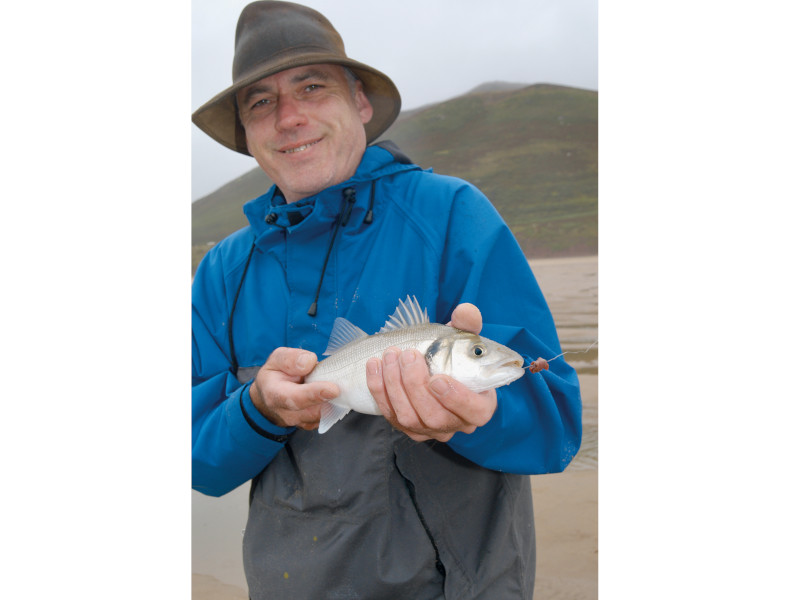
BAIT
In my early days fishing at Llangennith bass were always our primary target species. Freshly dug lugworm or razorfish were our baits of choice when fishing the surf, but in recent years I have used maddies almost exclusively for bait at Llangennith.
Known here in Wales as mudworm, and elsewhere as harbour ragworm, bunches of these tiny ragworm are a deadly bait for many species, notably flounder and golden grey mullet.
However, what surprised me when I first started using maddies at Llangennith and at other Welsh surf beaches, was the number of bass that I started to catch when using them.
Mostly these were undersized schoolies, but maddies not infrequently tempt much bigger fish. Of course, lugworm, both blow and black, remain an excellent bait for surf bass.
Other species, as are razorfish and pretty much any other type of shellfish. Whole sandeels or squid can be deadly if fishing specifically for better quality fish.
TACTICS
When fishing at Llangennith I use a light surf rod rated for casting 2-4oz, which I like to match with a small multiplier loaded with 12-18lb clear or natural coloured monofilament line.
Continental style surf outfits used with fixed spool reels are increasingly popular, especially with match anglers.
I like to keep my terminal rigs as simple as possible whenever fishing a surf beach, and typically use a single or twin hook paternoster tied with reasonably long 12-20in hook lengths.
I use long shank Aberdeen hooks such as the Sakuma 430 stainless in sizes 4-6 if fishing maddies, and larger 1-3/0 size when using lugworm, razorfish or sandeel.
My favourite time to fish at Llangennith is during the last couple of hours of the ebb tide, followed by the first hour or so of the flood. Other anglers prefer to fish the flooding tide up to and over high water.
Consistently over the years I have found that the most productive tides are mid-range, ideally on a rising sequence of tides.
The biggest mistake many anglers make when fishing here as at other surf beach is casting too far. The standard advice when I was growing up was to ‘cast beyond the third breaker,’ advice that still holds good today, especially for bass.
Typically look to cast 40-60 yards but if you are wading, which is how I like to fish any surf beach, there will often be times when fish are swimming about your feet, so a cast all but parallel to the shoreline may be all that is necessary.
Perfect conditions for a day’s surf fishing at Llangennith are created when a gentle Atlantic swell pushes a clearly defined line of shallow rollers onto the flat sands.
A south-westerly wind and low cloud with drizzle are the icing on the cake. Night fishing can be especially effective, especially for better quality bass.
Travel as lightly as you can at Llangennith. On big tides water can flood in very quickly causing tripods and tackle boxes to quickly become a nuisance.
Hold your rod when fishing and pack what you need, including bait, into a bag or pocket you can wade into the surf with.
Getting there
To get to Llangennith beach exit the M4 at junction 47 and follow the signs for Gower, then the A4295 north Gower road, turning right towards Llangennith at the petrol station.
At Llangennith follow the signs for the Hill End camp site beach car park where you pay a nominal charge to park a short distance from the beach.
Fish can be caught all along the beach. Hot spots include in front of the stream near Burry Holmes and the ‘White House’ further south.
Llangennith is a very popular surfing beach so during weekend and holidays, and when the surf is up, you may need to walk north towards Burry Holmes and away from the surfers.
Hill End campsite facilities include a shop, toilets and a café.
- Maddies and a wide range of other baits are available from Country Stores in Gowerton Tel: 01792 875050
- Mainwaring’s in Swansea Tel: 01792 202245.
Pendine Sands
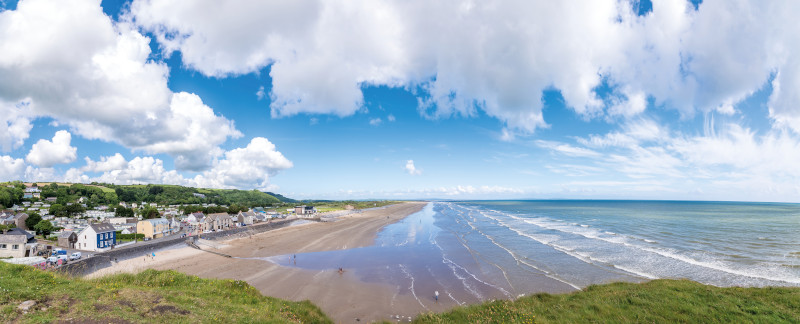
A seven-mile expanse of flat, golden sands that extends from the mouth of the Taf estuary at Ginst Point in the east to the picturesque holiday village of Pendine in the west, Pendine is a classic surf beach.
In addition to being one of the best known and productive surf beaches in the UK, at one time Pendine was the chosen venue for those attempting to break land speed records.
In the past anglers were allowed to drive onto the beach to fish, but unfortunately, due to the reckless activity of a few, all vehicular access is prohibited.
SPECIES
Like many other South Wales surf beaches you can catch fish at Pendine throughout the year.
My favourite times to fish here are during the autumn and spring, when given good conditions the flounder and bass fishing can be truly outstanding.
During the summer the beach is very popular with holiday makers, so I try to fish early in the morning or in the evening.
Bass and flounder can still be caught in good numbers throughout the winter. Other species caught include smoothounds, occasional plaice, turbot, as well as whiting and dogfish if fishing at night. Watch out for venomous weaver fish!
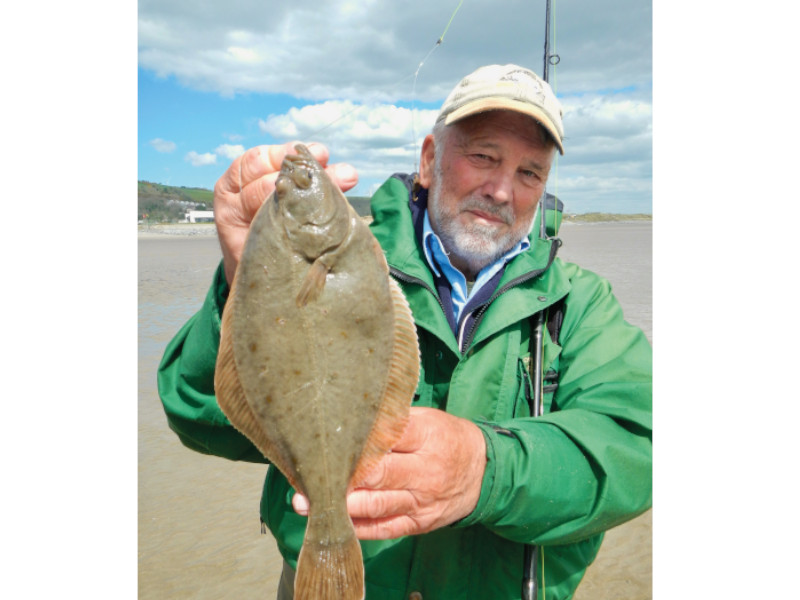
Spring and autumn produces excellent flounder fishing
CONDITIONS
Ideal conditions to fish at Pendine are when a steady oceanic swell is rolling in from the open Atlantic, thus creating two or three flat tables of surf.
Pendine is a very shallow beach and too much onshore wind, that’s any wind with a southerly aspect, will very quickly create messy surf conditions, with a mass of confused waves breaking for several hundred yards back from the surf line.
I do not like fishing any surf beach on big spring tides, especially very shallow beaches, and much prefer a mid-range set of tides. Locally this equates to tides between 11.2 and 11.8 Swansea scale.
TACTICS
Over the many years I have fished beaches here in South Wales I have found that the last two or three hours of the ebbing tide down to low water, followed by the first push of the flood tends to be the most productive period.
That said, the optimum time of tide to fish can vary considerably. If you start around low water and fish the flooding tide you’ll not go far wrong, especially if targeting flounder.
Many locals rate the high-water period as being the most productive for bass. The trick when fishing at Pendine is not to cast too far out, especially when fishing a flooding tide, when often the fish will be feeding very close in.
TACKLE
A simple two or three hook paternoster is an effective rig for general fishing on Welsh surf beaches. If flounder or golden grey mullet are my target species I use Sakuma 410 stainless steel hooks in sizes between size 2 and 4, occasionally down to size 6.
If targeting bass, I prefer a single hook paternoster with a larger size 1/0 up to 3/0 hook. All of my surf rigs are tied with an absolute minimum of components with the hook snoods, 12-18in in length cut from clear 15lb monofilament.
More often than not I fish within 60 yards from the surf line, often much closer and I like to use the lightest lead possible, which usually means a plain bomb of between 2oz-4oz.
I do carry a few grip leads for use whenever the surge of the surf is really lively.
GETTING THERE
To get to Pendine Sands, follow the signs from the A477 between Carmarthen and Tenby. Once you arrive in the village you will find a large pay and display car park next to the beach.
Access to the opposite end of the beach is possible by driving along the coast road from Pendine Village to Ginst.
Aside from offering good fishing, Pendine Sands are an excellent venue for digging/pumping black lug.h.
TACKLE SHOPS
- Anglers Corner Milford Haven, Tel: 01646 698899
- Anglers Corner Llanelli, Tel: 01554 773981
Brandon Bay
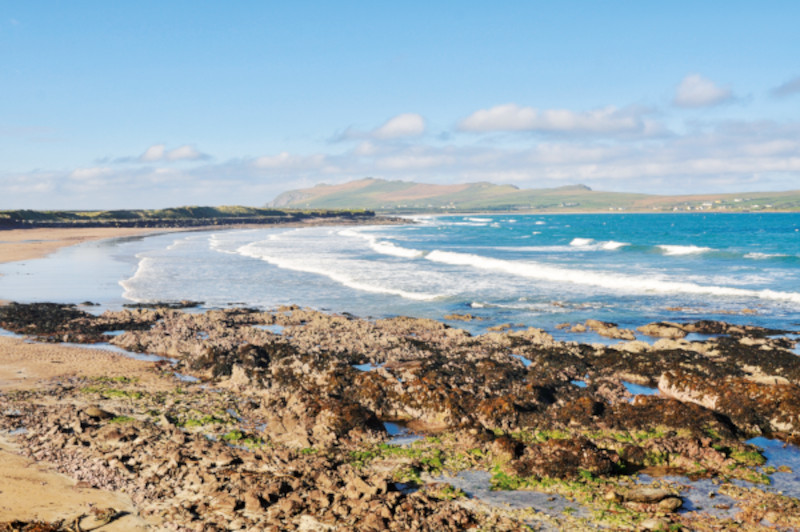
Looking across Brandon Bay
On the northern shore of the Dingle Peninsula lies the famed surf beaches of Brandon.
This is actually an 11km long stretch of beach, with various names along its length: Fermoyle at the western end, then Kilcummin, Gowlane and finally Stradbally.
Although northern facing, these are true surf beaches, the swell coming around Brandon Head can put a fine row of breakers on even calm days.
If the surf is too big, try Fermoyle at the western end, by Brandon Head ,which is a little more sheltered.
If Fermoyle is flat calm, there may be nice surf on Stradbally.
Stradbally also has more lateral tide which is almost unnoticeable by the time you reach Fermoyle.
Weed can sometimes be a problem, but rarely covers the whole bay and you will usually find clear water by moving.
A big surf here can have a massive surge, particularly on big tides, so anglers should be cautious wading out to cast or retrieve a fish, as the surge can catch you out, particularly at night.
I have fished it on a stormy night when we had to be very aware of our surroundings, but even in those conditions we had bass and painted (small eyed) ray.
The beach is very popular with surfers, but on 11km of coast there is usually plenty of room for everyone.
The Fishing
Known for the bass fishing, Stradbally also produces flounder, turbot, sea trout, thornback and painted ray, coalfish and dogfish.
Bass is the primary quarry here, with bait fishing producing fish through the autumn and winter, and spinning lures very successful in summer. Flatties are caught all year round, with the best fishing in early autumn.
The Kilcummin/Fermoyle end is known for the ray fishing, with painted ray up to 12lb being targeted in autumn in particular.
The ray are found in the surf tables and don’t require a massive cast. Big sandeel baits will work well for the rays.
The whole beach fishes well for the first half of the flood. Fermoyle and Stradbally continue to fish well towards the top of the tide, while Gowlane fishes well on the ebb down to low tide.
Nearby Cloghane estuary, just west of Fermoyle, provides excellent bait and lure fishing for bass, flounder and sea trout. Peeler crab is the preferred bait here. Note that a licence is required for sea trout fishing.
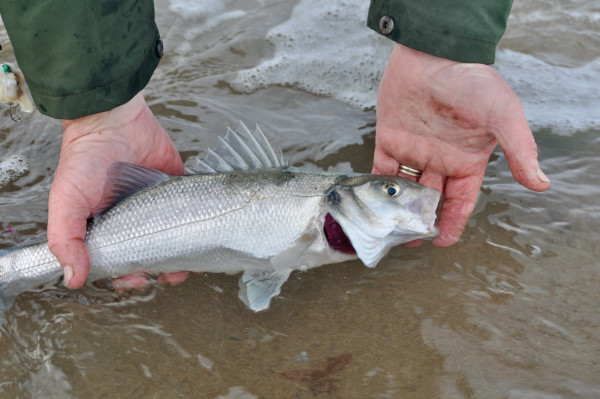
Access
The beach can be accessed at several points via tracks off the main road, all signposted. It is possible to drive onto the beach, but this not advised due to the soft sand in places.
Bait
Lugworm is the most popular bait, and can be dug in the estuary west of Fermoyle and at Kilshannig, at the end of the Maharees headland.
Mackerel can be caught off Brandon Pier in summer, but the nearest bait supply is the tackle shops in Tralee – Landers and the (excellent) Angling Hub.
The Angling Hub is run by Martin McGowan, a keen angler himself, and a mine of information.
Worm and crab can be ordered in advance. Sandeel is a top bait for the ray, which move in in summer and are caught into early winter.
Getting there
Get the ferry to Dublin (routes from Holyhead and Liverpool) or Rosslare (from Pembroke).
Dingle is a 4.5 hour drive from Rosslare and similar from Dublin. Stradbally is a 25 minute drive from Dingle, or just over 30 minutes from Tralee.
Stay
Castlegregory is a charming little village at the eastern end of Stradbally, and there are many self-catering cottages and B&Bs in the area.
Dingle town, on the far side of the scenic Connor Pass, is the biggest accommodation centre in the area, and is famous for its sheer number of pubs, offering plenty of options for post-fishing entertainment.
Check out www.discoverireland.ie for recommended accommodation options.
INCH
A few miles east of Dingle, on the southern side of the Dingle Peninsula, lies a 5km long sand spit that protects Castlemaine Harbour from the Atlantic storms that sweep in through autumn and winter.
Taking the brunt of those storms, Inch has been the spiritual home of storm surf fishing since at least the 1960s. It’s a rare day when there is no surf on Inch, and many days when the row of breakers seems to stretch for miles.
It is shallow, so the surf tables stretch out a long way, but fish can be found surprisingly close in those tables.
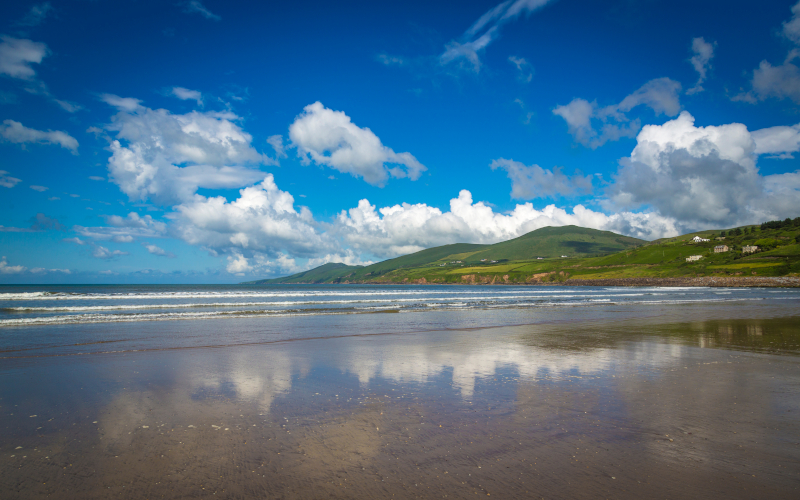
Inch Beach
The Fishing
Bass are the main attraction on Inch, and it is bass that draws anglers from all over to fish it.
There are good stocks of flatfish too, flounder, turbot and dabs, with flounder dominating catches, especially at the car park end. You can expect dogfish and occasional ray here too, especially at night and in calmer conditions.
Fishing the flood tide and a couple of hours into the ebb offers the best results. Weed can sometimes be an issue, but moving along the beach will often find clearer water.
Further down the beach, as you near the end of the spit and the main channel, deeper gullies are formed and these hold dabs and thornback ray. Dogfish, bass and flounder are also caught here.
Tope can be targeted here, usually at night on a flood tide in summer, and further on from the end of the spit casting into the channel.
The back bay behind the sand dunes dries out at low tide, but fishing into the channel bass, flounder and occasional stingray can be caught on peeler crab, with the last of the flood and start of the ebb the best time.
The rocky shoreline to the west of Inch, from the car park end, is also a good mark for lure fishing for bass. Rocks and kelp predominate here, making weedless soft plastics an ideal choice.
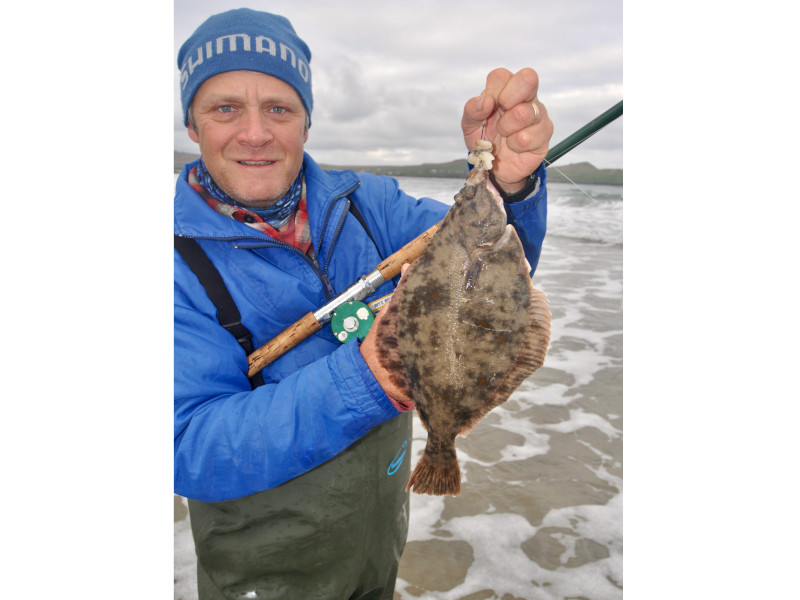
Access
There is a car park at the single entrance to the beach, Many people drive onto the beach, but cars getting stuck in soft sand is a common occurrence, so it is not advised.
The local farmer makes a tidy income from towing stuck cars with his tractor – enough said!
There is a bar and restaurant – Sammy’s – at the entrance to the beach, which is very handy when fishing the car park end.
Bait
Lugworm can be dug in the bay behind the spit, and is the most popular bait, maddies (harbour ragworm), work very well for flounder.
The nearest bait supply is the tackle shops in Tralee – the Angling Hub and Landers. The Angling Hub is run by Martin McGowan, a keen angler himself, and a mine of information. Worm and crab can be ordered in advance.
Getting there
Get the ferry to Dublin (routes from Holyhead and Liverpool) or Rosslare (from Pembroke). Dingle is a 4.5 hour drive from Rosslare and similar from Dublin. Inch is a 20 minute drive from Dingle, or just over 30 minutes from Tralee.
Stay
There is a fully serviced campsite adjacent to the beach (www.inchbeach.com) with B&B and self-catering cottages also available on site.
Next door, the Seafront Inn offers B&B accommodation, and has a great bar and restaurant with stunning views over the bay.
The Dingle Peninsula has a huge range of accommodation, from self-catering cottages to B&Bs and 4-star hotels. Dingle Town is the nearest large town with plenty of nightlife and restaurants.
Tralee is another large centre with plenty of accommodation options.
Check out www.discoverireland.ie for recommended accommodation options.




